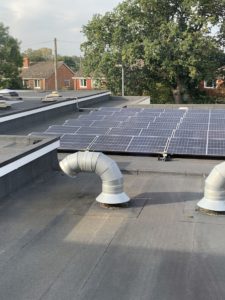We’re delighted to kick off 2021 with another addition to the Buildpass Guest Post Series. Today, we’re hearing from Chris Ingram, Founder of Continal Underfloor Heating and nine-times Chairman of the UK underfloor heating trade association.
Energy efficiency is back on the UK agenda with the publication of the government’s ’10-point plan for a green industrial revolution’.
As part of the government’s goal to ‘build back better’ following the COVID-19 pandemic, the 10-point plan outlines £12 billion of funding – with up to three times as much anticipated from the private sector – to make the UK a global leader in green technologies and to accelerate the UK’s path to achieving net-zero carbon emissions.
Much of this funding will be given to UK infrastructure projects, but among those 10 points is a significant investment in making homes more energy efficient, as the UK moves away from fossil fuel boilers and towards low-carbon heating sources such as hydrogen and heat pumps. There will also be higher energy efficiency requirements for private sector landlords, and grants made available to upgrade the heating in homes in off-grid areas.
The government hopes this policy will improve the energy efficiency of around 2.8 million homes, with 600,000 heat pumps being installed every year by 2028.
This ambitious goal would help to reduce UK carbon emissions drastically, and should also prompt UK homeowners to once again consider having low-carbon heating technologies fitted in their homes.
Of course, you can’t just remove a gas boiler and fit a heat pump in its place without stopping to consider the rest of the system. Heat pumps tend to run on lower flow temperatures than gas boilers, and so anyone who tries a straight swap on a system using radiators will likely find their radiators no longer get as hot as they’re used to, potentially causing cold rooms and unhappy occupants.
Instead, those considering a low-temperature heating system need to consider further investment in improvements to their building fabric, such as insulation, to maximise the energy efficiency benefits without sacrificing comfort.
Homeowners should also consider upgrading their heat emitters to a more efficient option, such as underfloor heating (UFH).
UFH is around 30% more efficient than radiators, especially when connected to heat pumps and other such low-carbon systems.
It is much easier than you might think to fit UFH into an existing building that is already undergoing renovation, especially now that there are so many different types of UFH system such as overfloor, solid floor, and suspended floor options, as well as slimline options that can be installed on top of existing floors, without raising the floor height significantly. However, the UFH system must be properly designed and specified, and it is vital that floor insulation levels are checked to ensure heat energy isn’t wasted.
The current Green Homes Grant has already begun to generate interest among homeowners for domestic energy efficiency improvements.
Upcoming initiatives such as the government’s Heat and Buildings Strategy, Future Homes Standard, and Homes Upgrade Grant make it clear that this is not just another false dawn for renewable and low-carbon systems.
But it is up to tradespeople and the heating industry to ensure that people consider these improvements as part of a more holistic, whole-house approach to efficiency, wherever possible, upgrading as much of the home as possible to ensure that they become truly energy efficient.
Continal has been one of the UK’s leading design and supply specialists for energy-efficient warm-water UFH for 20 years. The company’s full range of UFH systems for solid floors, overfloor applications and joist floors, as well as a full portfolio of controls and accessories, can be found at www.ufh.co.uk.





















